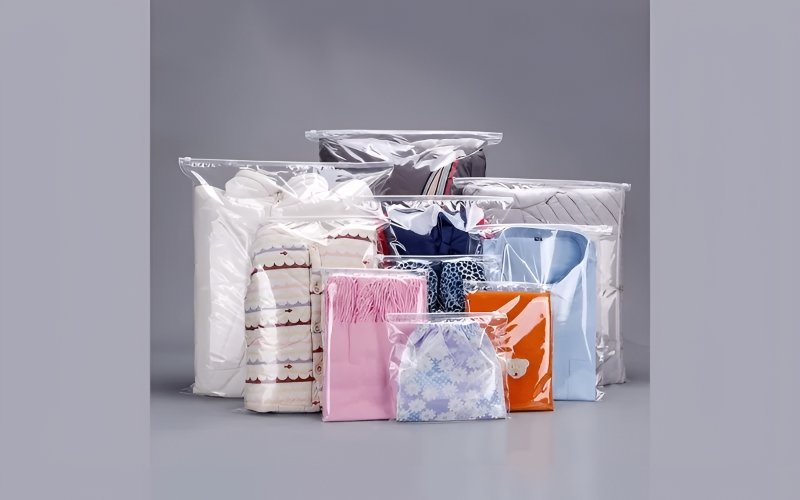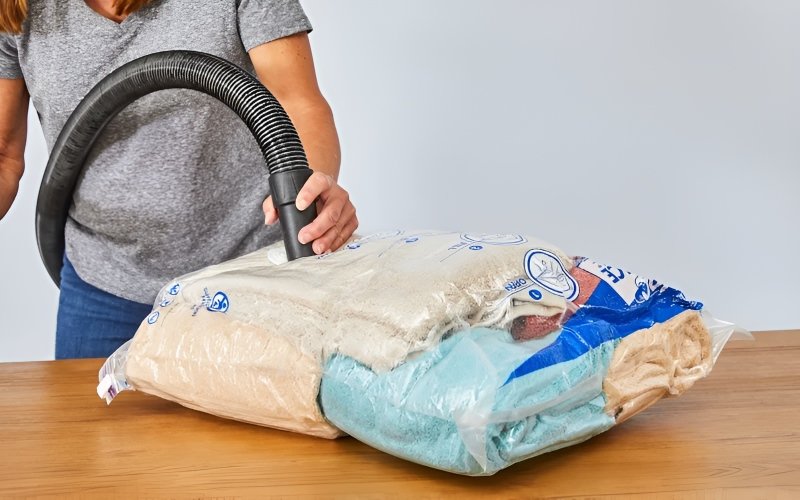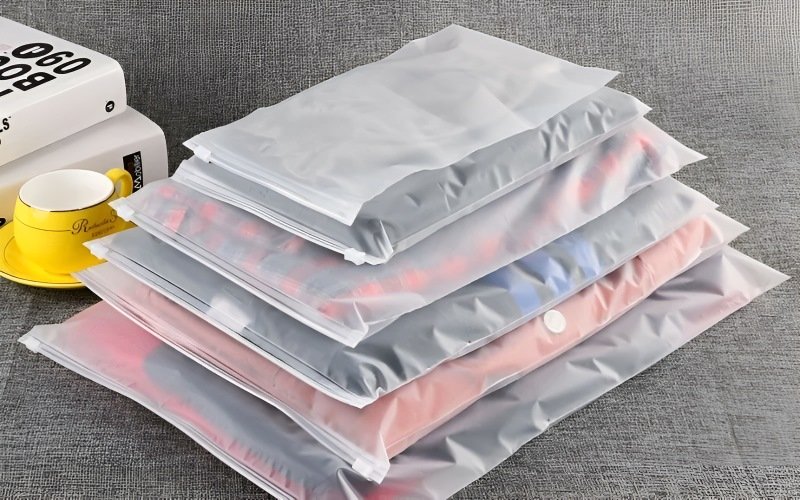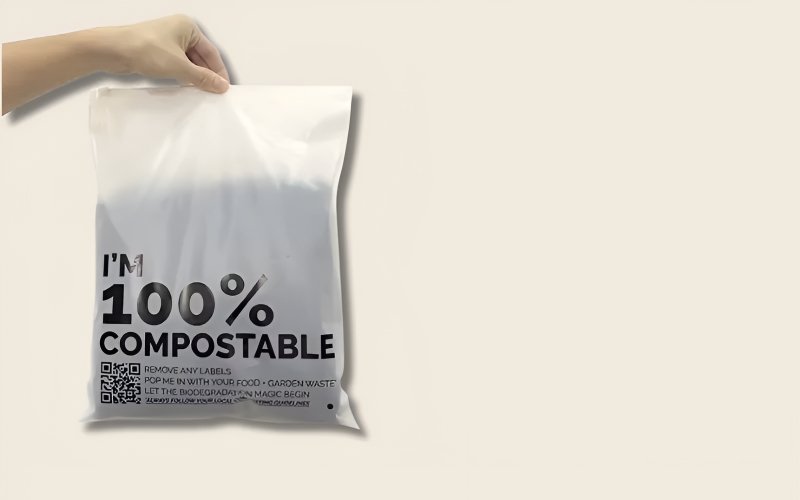Clear Zipper Bags: Garment Protection and Organization
Are your meticulously chosen outfits getting lost in the depths of a disorganized closet? Do you dread opening your suitcase after a long journey, only to find your favorite shirt wrinkled and creased? Or perhaps you’re a clothing retailer searching for a way to protect your merchandise while keeping it visible and appealing to customers?
These are common struggles, whether at home, on the road, or in a shop. From dust and pests to wrinkles and the general wear and tear of storage and transport, clothes often face a barrage of challenges. This article is your ultimate guide to a simple, yet incredibly effective solution: clear zipper bags. These aren’t just ordinary plastic bags; they’re a versatile tool for protecting, organizing, and presenting your garments.
This comprehensive guide will walk you through everything you need to know, showing how using transparent garment bags effectively solves these problems. From choosing the right size and material to optimizing storage and display.
Whether you’re looking to streamline your closet, protect your clothes during travel, or enhance your clothing packaging for retail, you’ll find practical, expert-backed advice here. We’ll cover the full spectrum of benefits, helping you achieve optimal garment protection and organization.
1. Why choose clear zipper bags for your clothes?
1.1 Unmatched protection
Clear zipper bags create a robust barrier against a multitude of threats to your garments:
- Dust Protection: Shield your clothes from accumulating dust, keeping them clean and fresh, even during long-term storage. Think of storing a winter coat during the summer months – completely dust-free when you need it again.
- Moisture Barrier: Prevent damage from humidity, spills, and leaks. This is especially crucial in humid climates or for storing clothes in basements or attics.
- Pest Deterrent: Keep moths, insects, and other pests away from your valuable clothing. No more worrying about finding holes in your favorite cashmere sweater.
- UV Protection: Certain types of clear zipper bags offer UV protection, helping to prevent fading of colors, especially for delicate fabrics or items stored near windows.

1.2 Superior organization
Transform your closet or storage space from chaos to clarity:
- Visibility of Contents: Easily see what’s inside each bag without having to open it, saving you time and effort when searching for a specific item.
- Space Saving: Compress garments and stack bags neatly, maximizing your storage space. This is particularly beneficial for smaller closets or when storing seasonal clothing.
- Clothing Organization: Categorize your clothes by type, season, or occasion, making it simple to find exactly what you need. For instance, separate bags for sweaters, dresses, and activewear.

1.3 Ideal for travel & shipping
Make packing and shipping a breeze:
- Travel Packing: Compress clothes to save space in your luggage, and keep items organized and wrinkle-free. Separate clean and dirty clothes easily.
- Protection: Safeguard your garments from spills, dirt, and damage during transit.
- Shipping Protection: For businesses, ensure that clothing arrives at its destination in pristine condition, minimizing returns and customer dissatisfaction.
- Lightweight: These bags will protect clothes during transport without adding significant weight.
1.4 Perfect for retail display & presentation
Elevate your brand and protect your merchandise:
- Retail Display: Showcase clothing in a clear, professional manner, allowing customers to easily see the product while protecting it.
- Presentation: Create a clean, organized, and visually appealing display that enhances the perceived value of your products.
- Garment Protector Bags: Protect clothing from dust, fingerprints, and other handling damage, keeping items in perfect condition for sale.
- Enhance Brand Image: Showing customers that a business cares about the condition that products will arrive in can increase customer satisfaction.
2. Types of clear zipper bags: Finding the perfect fit
Choosing the ideal clear zipper bag involves more than just grabbing the first one you see. These versatile clothing packaging solutions come in a variety of materials, closure types, sizes, and with optional special features.
Understanding these differences is key to selecting the perfect bag for garment protection and organization, tailored to your specific requirements. The best choice hinges on how you intend to use the bags – whether for personal storage, travel, or retail display. Let’s delve into the various options to help you make an informed decision and find the best see-through clothes bags for your needs.
2.1 By material
The material of a clear zipper bag significantly impacts its performance, cost, and suitability for different applications. Here’s a breakdown of the common options:
Polyethylene (PE): PE is a widely used, affordable plastic known for its flexibility and moisture resistance.
- Pros: Cost-effective, lightweight, provides good moisture protection, readily available.
- Cons: Lower clarity compared to PP, less durable (more prone to tearing), not ideal for sharp objects.
- Best For: Budget-conscious homeowners, short-term storage, protecting lightweight clothing items.

Polypropylene (PP): PP offers superior clarity and greater durability compared to PE.
- Pros: Excellent clarity (ideal for retail display), more durable and tear-resistant than PE, good moisture resistance.
- Cons: Slightly more expensive than PE.
- Best For: Retailers, businesses shipping clothing, long-term storage, situations where visual appeal is important.
Other Materials (e.g., PVC, Eco-Friendly Alternatives): While less common for zipper bags specifically designed for clothing, other options exist.
- PVC (Polyvinyl Chloride): PVC is known for its durability, but it has environmental concerns due to its manufacturing process and potential for releasing harmful chemicals. It is generally not recommended for direct contact with clothing, especially for long-term storage.
- Eco-Friendly Alternatives: Biodegradable and compostable options are becoming increasingly available, often made from plant-based materials. These are a good choice for environmentally conscious consumers and businesses. However, it’s crucial to check their specific certifications (e.g., BPI certified compostable) to ensure they meet your sustainability goals. They may also have limitations in terms of durability and shelf life.
| Material | Pros | Cons | Best For |
|---|---|---|---|
| Polyethylene (PE) | Cost-effective, lightweight, good moisture protection | Lower clarity, less durable, not ideal for sharp objects | Budget-conscious homeowners, short-term storage, lightweight clothing |
| Polypropylene (PP) | Excellent clarity, more durable, good moisture resistance | Slightly more expensive than PE | Retailers, shipping clothing, long-term storage, visual appeal |
| Other Materials | PVC: Durable (but has environmental concerns); Eco-friendly: Sustainable | PVC: Not recommended for clothing; Eco-friendly: May have limitations | Varies depending on the specific material |
2.2 By closure type
The closure mechanism of a clear zipper bag affects its ease of use, security, and overall functionality. Here are the primary types:
Standard Zipper: This is the most common type, featuring interlocking teeth that are joined and separated by pulling a slider.
- Advantages: Familiar, readily available, relatively inexpensive.
- Disadvantages: Can be less secure than other options (prone to accidental opening if not fully closed), may require more effort to open and close, especially with larger bags.
- Best For: General storage, situations where maximum security isn’t the primary concern.
Slider Zipper: This type features a plastic slider that glides along the zipper track, making it easier to open and close the bag.
- Advantages: Easier and faster to open and close than a standard zipper, especially with one hand, provides a more secure closure.
- Disadvantages: Slightly more expensive than standard zipper bags.
- Best For: Frequent use, travel, situations where ease of access and a good seal are important.
Double Zipper: This option features two zippers, providing an extra layer of security and protection.
- Advantages: Most secure closure, offers enhanced protection against dust, moisture, and pests, less prone to accidental opening.
- Disadvantages: Can be slightly more cumbersome to open and close, typically the most expensive option.
- Best For: Long-term storage, valuable items, situations where maximum protection is paramount.
2.3 By size and shape
Clear zipper bags come in a wide array of sizes and shapes to accommodate virtually any garment. Choosing the right dimensions is crucial for optimal storage and protection.
- Small Bags (for accessories, underwear, socks): These compact bags are perfect for organizing smaller items, preventing them from getting lost or damaged. They are also excellent for travel, keeping accessories neatly contained within your luggage.
- Medium Bags (for shirts, sweaters, pants): These versatile bags are ideal for a wide range of everyday clothing items. They provide ample space for folded shirts, sweaters, and pants, keeping them protected and organized.
- Large Bags (for dresses, coats, suits): These larger bags are designed for longer or bulkier garments. They offer sufficient length for dresses and coats, preventing wrinkles and keeping them in pristine condition. Suits can be neatly stored, maintaining their shape and protecting them from dust.
- Gusseted Bags (for bulkier items): Gusseted bags feature expandable sides, providing extra room for thicker or more voluminous items like blankets, pillows, or multiple garments. This added capacity makes them ideal for maximizing storage space.
- Bags with Hanger Holes: These bags are specifically designed for hanging garments in a closet. The hanger hole allows you to insert a hanger, keeping clothes wrinkle-free and readily accessible. They offer the benefits of a traditional garment bag with the added protection and visibility of a clear zipper bag.
2.4 By special features
Beyond the basic options, some clear zipper bags offer additional features that enhance their functionality and convenience:
- Reinforced Seams: Bags with reinforced seams are constructed with extra stitching or thicker material along the edges, providing increased durability and preventing tearing, especially when storing heavier items or during frequent handling.
- Handles: Some larger zipper bags come with built-in handles, facilitating easier carrying and transport. This is particularly useful for bulkier or heavier contents.
- Antistatic: Antistatic bags are treated with a special coating that reduces static electricity buildup. For clothing storage, its value is minimal, unless dealing with extremely delicate materials prone to static cling.
3. Choosing the right clear zipper bag: A step-by-step guide
Selecting the perfect clear zipper bag can seem overwhelming given the variety of options. This step-by-step guide simplifies the process, ensuring you make the best choice for your specific needs:
- Identify Your Needs: Are you primarily looking for storage, protection, organization, presentation, or transportation? Will the bags be used at home, for travel, or in a retail setting? Consider the primary purpose to narrow down your options.
- Determine the Garment Type(s): What type of clothing will you be storing or displaying? Delicate items like silk scarves require different protection than bulky winter coats. Consider the size, shape, and fragility of the garments.
- Choose the Material: Based on your needs and garment type, select the appropriate material. Polyethylene (PE) is a budget-friendly option for general storage, while Polypropylene (PP) offers superior transparency and durability, making it ideal for retail or long-term storage. Consider thickness as a factor for material.
- Select the Closure Type: Choose a closure that balances ease of use with security. A standard zipper is suitable for basic storage, while a slider zipper offers convenience, and a double zipper provides maximum protection.
- Consider Special Features: Determine if any special features are necessary. Reinforced seams add durability, handles enhance portability, and antistatic properties are relevant for specific materials (though less crucial for most clothing).
- Determine the Quantity: Estimate how many bags you need based on the number of garments you plan to store or display. It’s often more cost-effective to purchase bags in bulk, especially if you have ongoing storage or retail needs.
4. Sustainable solutions: Eco-friendly clear zipper bag options
Traditional plastic zipper bags, while convenient, contribute to environmental concerns due to their reliance on fossil fuels and slow decomposition rates. Thankfully, a growing awareness of sustainability has led to the development of eco-friendly packaging options. It’s important to understand the nuances of these alternatives:
- Biodegradable Bags: These bags are designed to break down into natural components (like carbon dioxide and water) under specific conditions, typically involving microorganisms. However, “biodegradable” can be a broad term. Some bags may only biodegrade in industrial composting facilities, not in a home compost bin or landfill.
- Compostable Bags: These bags go a step further than biodegradable. They break down into compost, a nutrient-rich soil amendment, within a specific timeframe and under specific conditions (usually in a commercial composting facility). Look for certifications like BPI (Biodegradable Products Institute) to ensure the bags meet composting standards.
- Reusable Bags: While not clear in the traditional sense, reusable garment bags made from durable materials like cotton, canvas, or recycled fabrics offer a sustainable alternative. These can be used repeatedly, significantly reducing waste compared to single-use plastic bags.
It is important for businesses to do their due diligence in researching the best eco-friendly options. While striving for sustainable solutions, it is important to check if a product is truly green.

Read more: Zipper Bag Materials: Plastic, Fabric and Eco-Friendly Options
5. Tips & tricks for using clear zipper bags effectively
To get the most out of your clear zipper bags, consider these practical tips:
- Folding Techniques for Maximizing Space: Proper folding is key to efficient storage. Consider the “rolling” method for items like t-shirts and sweaters, which minimizes wrinkles and saves space. For bulkier items, fold them as flat as possible, pressing out excess air before sealing the bag.
- Labeling and Organization Systems: Label each bag with its contents for easy identification. You can use adhesive labels, write directly on the bag with a permanent marker (if the material allows), or use tags that slip into a pocket on the bag. Consider organizing bags by category (e.g., “Winter Sweaters,” “Summer Dresses,” “Travel Clothes”).
- Cleaning and Maintaining Your Bags: Most clear zipper bags can be wiped clean with a damp cloth and mild soap. For tougher stains, check the manufacturer’s instructions. Ensure the bags are completely dry before storing items to prevent mildew.
- Using Desiccants for Added Moisture Protection: In humid environments or for long-term storage, consider adding desiccants (silica gel packets) to the bags. Desiccants absorb excess moisture, helping to prevent mildew and musty odors. This is especially important for delicate fabrics like silk or wool. Proper garment care and preservation often involves controlling humidity.
6. Related questions
Here are a few additional questions that often arise regarding clear zipper bags:
6.1 Can clear zipper bags be used for long-term storage?
Yes, clear zipper bags are excellent for long-term storage, provided you choose the right type. For long-term storage, opt for thicker, more durable bags (like polypropylene), and consider adding desiccants for moisture control. Ensure the bags are stored in a cool, dry place away from direct sunlight.
6.2 Are clear zipper bags airtight?
While most clear zipper bags provide a good seal, they are not always completely airtight. The level of airtightness depends on the quality of the zipper and the material. Double-zipper bags offer the best seal, but even standard zipper bags significantly reduce airflow, protecting garments from dust, pests, and moisture.
6.3 Can you wash clothes that are stored in zipper bags?
It is recommended to remove clothes from zipper bags before washing. Zipper bags are designed to protect clean clothes.
6.4 How do I choose the right size zipper bag for my clothes?
Measure the dimensions of the folded garment and choose a bag that provides a comfortable fit without being too tight or too loose. Allow a little extra space for thicker items. For dresses and coats, measure the length to ensure the bag is long enough.
6.5 Where can I buy Clear Zipper Bags?
Clear zipper bags can be bought from a variety of different sources, both online and offline. Some examples include: Amazon, Walmart, Etsy, ClearBags, Uline.
Read more:
Clear zipper bags are far more than just simple storage containers. They are a versatile and effective solution for protecting, organizing, and presenting your clothing, whether you’re a homeowner, a frequent traveler, or a clothing retailer.
From safeguarding delicate fabrics against dust, moisture, and pests to streamlining your closet and enhancing retail displays, these bags offer a multitude of benefits. By understanding the different types of bags available and following the tips for effective use, you can transform the way you manage your garments.
Embrace the power of clear zipper bags to unlock the potential of a truly organized and protected wardrobe or clothing inventory. It’s time to experience the peace of mind that comes with knowing your clothes are safe, secure, and readily accessible whenever you need them.
Visit our website https://mypacklove.com/ to explore our product options and request a quote. Contact us today to discuss your specific needs! Let us help you enhance your clothing care and branding efforts.






















